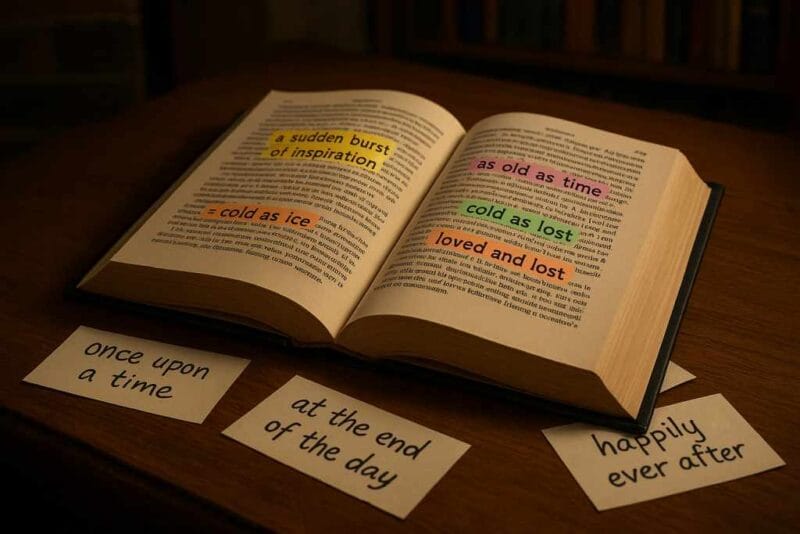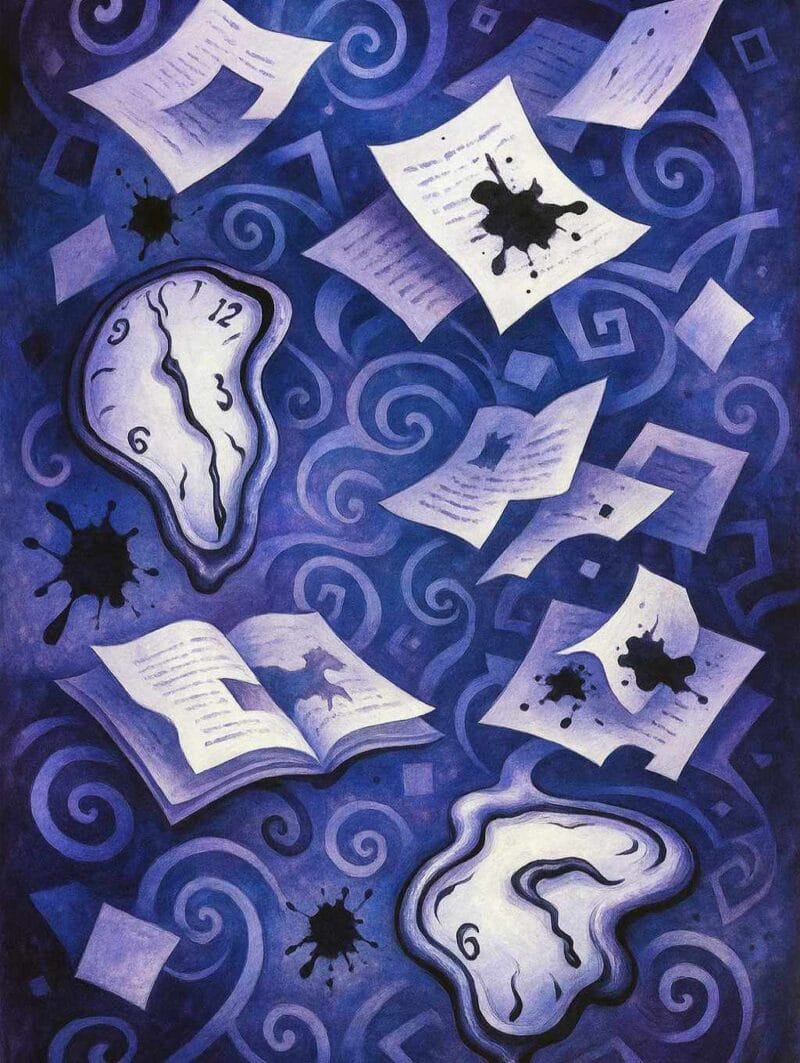In literature, tension often breathes life into expression, and nowhere is this more concentrated than in the figures of paradox and oxymoron. Both challenge logic, and both traffic in contradiction, and yet, the mechanisms they use and the effect they produce differ in ways that matter.
Whether used to disrupt certainty, compress irony, or deepen conceptual ambiguity, the distinction between paradox and oxymoron lies in their scale, structure, and rhetorical function. Understanding this distinction sharpens our reading of classic texts, where such devices are neither ornamental nor incidental.
Definition of Paradox in Literature
A paradox presents an apparently self-contradictory statement that, upon reflection, expresses a deeper or unexpected truth. It unfolds as a conceptual puzzle that pushes past initial contradiction to reveal coherence. Paradox often engages the structure of logic in order to subvert it—asserting something that seems illogical or impossible, only to compel the reader to reconsider the framework through which logic operates.
Take this line from Oscar Wilde’s Lady Windermere’s Fan (1892):
“I can resist everything except temptation.”
The sentence defeats itself but does so elegantly by capturing a human impulse that cannot be reconciled with a simple moral binary. Wilde’s wit depends on contradiction that cannot be resolved by grammar alone because it must be worked out in thought.
In religious and philosophical texts, paradox takes on a more solemn quality. The Gospel verse, “For whoever wants to save their life will lose it, but whoever loses their life for me will find it” (Matthew 16:25), functions as theological instruction encoded in contradiction. Here, paradox doesn’t obscure but sharpens the point through rhetorical reversal.
Definition of Oxymoron in Literature
An oxymoron, by contrast, is a compact collision of two contradictory terms. It is not a sentence but a phrase, typically two words, where discord between the words is both immediate and irreconcilable on a literal level. The effect lies in the compression: an oxymoron fuses opposition into a single linguistic unit, often with dramatic or poetic potency.
In William Shakespeare’s Romeo and Juliet (1597), for instance, Romeo voices his confusion through a string of oxymorons:
“O brawling love! O loving hate! / O anything, of nothing first create!”
Here, oxymoron becomes the grammar of emotional chaos. The play of “loving hate” and “brawling love” mirrors the characters’ tangled loyalties and the fusion of desire with destruction. Each pair carries its own contradiction, but in such condensed form that it becomes almost musical, a beat of semantic dissonance that requires no further elaboration.
Another example appears in John Milton’s Paradise Lost (1667) where the phrase “darkness visible” describes the infernal gloom of Hell. The words remain in tension, irreducible to explanation. Unlike paradox, the oxymoron does not lead to reconciliation but constantly remains in suspension.
Paradox vs. Oxymoron: Structural Difference
The structural difference between paradox and oxymoron is crucial. On one hand, a paradox is a full proposition or statement; it can span a sentence or more. An oxymoron, on the other hand, is nearly always a pair of words where one unfolds as a conceptual problem and the other strikes with stylistic immediacy.
Paradox stimulates the mind in a process by engaging interpretation and encouraging the reversal of assumptions. An oxymoron presents a flash of conflict in miniature wherein it serves as a rhetorical capsule for contradiction.
In syntactical terms:
- A paradox relies on context and clause: “This statement is false.” (known as the Liar Paradox)—a sentence whose truth value creates a contradiction that arises from the logical meaning of the entire proposition. You have to think about the consequences of it being true and the consequences of it being false.
- An oxymoron fits into a phrase or noun: “bittersweet,” “deafening silence,” “original copy.” The contradiction is immediate and contained within the words themselves. You don’t need a larger sentence or context to spot the clash; it’s right there between the two terms.
This difference matters in literature because it influences where and how each device is used. Paradox can establish theme, while oxymoron tends to work on the level of mood, tone, or poetic texture.
Paradox and Oxymoron Similarities
Despite their differences in scale and syntax, paradox and oxymoron operate along a shared fault line: contradiction. Both thrive on opposition therefore they both force the reader into interpretive hesitation. Neither permits a simple conclusion.
Each also functions as a disruption. Both can disturb linear reasoning, whether by halting the flow of logic (paradox) or jolting the rhythm of language (oxymoron). Both enrich ambiguity and make room for irony, doubt, and self-reference. In poetic language, they may heighten emotional or intellectual tension through deliberate withholding of clarity.
Consider the lines from T. S. Eliot’s Four Quartets (1943):
“In my beginning is my end … In my end is my beginning.”
This is a paradox, not an oxymoron. But its circular structure echoes the compression that oxymoron achieves in shorter phrases. While Eliot’s statement spins contradiction outward into a meditation on time and continuity, Four Quartets also includes paradoxical expressions, such as “the still point of the turning world,” which lock contradiction into a compact poetic beat.
Use of Paradox and Oxymoron in Classic Literature
Writers use paradox and oxymoron to engage contradiction without neutralizing it. In classic literature, these devices are not tricks of phrasing but devices of thinking. They make visible the contradictions embedded in moral conflict, metaphysical inquiry, and emotional ambiguity.
In Shakespeare’s Hamlet (1603), for example, the entire arc of the protagonist is riddled with paradox:
“I must be cruel, only to be kind.”
This is not simply wordplay because it expresses a psychological crisis wherein action and intention cancel one another. The statement breaks conventional ethical logic, yet does so in order to clarify a deeper anguish. Meanwhile, in As You Like It (1623), the phrase “noble fool” becomes an oxymoron that encapsulates the character of the Fool: truth-teller and comic, simultaneously naive and profound.
In poetry, the metaphysical poets leaned heavily on both forms. John Donne’s Holy Sonnets (1633) and The Flea (1633) are structured around paradoxical conceits that challenge sacred-profane binaries. At the same time, oxymorons provide linguistic texture that makes arguments sensuous and strange. Phrases like “glorious nothing” from Donne’s “Air and Angels” (1633) or “sour-sweet” from George Herbert’s “Bitter-Sweet” (1633) carry too much contradiction to flatten into literal sense.
Literary Function: Beyond Contradiction
Paradox and oxymoron belong to the field of figurative language, but their function differs from metaphor or simile. Where metaphor seeks resemblance, paradox and oxymoron stake their power on dissonance. They introduce disquiet and preserve tension.
In some cases, paradox becomes the architecture of a text’s entire premise. In George Orwell’s 1984 (1949), the slogans “War is peace. Freedom is slavery. Ignorance is strength.” form a political paradox that critiques the breakdown of language into authoritarian contradiction. These slogans cannot be parsed because they are meant to confuse the very mechanism of thought.
Oxymoron, meanwhile, often appears in modernist poetry and dramatic monologue. T. S. Eliot’s “paralysed force” (taken from “The Hollow Men,” publ. 1925) or W. B. Yeats’s “terrible beauty” (from “Easter, 1916,” publ. 1916) are phrases that fuse sense into friction. The contradiction carries the potency of the phrase. An oxymoron does not require the reconciliation that a paradox seeks because it is self-contained and left intentionally open.
Summary Table: Differences Between Paradox and Oxymoron
| Feature | Paradox | Oxymoron |
|---|---|---|
| Structure | Full statement or proposition | Two-word phrase |
| Function | Conceptual contradiction | Compressed contradiction |
| Length | Clause or sentence | Single phrase (often noun + adjective) |
| Resolution | Can be reconciled conceptually | Rarely resolved |
| Example | “This is the beginning of the end” | “Bittersweet,” “Deafening silence” |
| Literary Role | Philosophical, thematic | Stylistic, tonal |
Further Reading
Paradox Definition by LitCharts
100 Awfully Good Examples of Oxymorons by Richard Nordquist, ThoughtCo.
Please explain to me the difference between a paradox and an oxymoron on Reddit
Where is the boundary (if any) between oxymoron and paradox? on StackExchange




